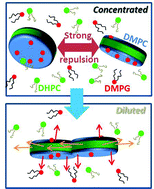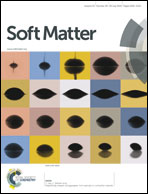Lipid-based nanodiscs as models for studying mesoscale coalescence – a transport limited case
Abstract
Lipid-based nanodiscs (bicelles) are able to form in mixtures of long- and short-chain lipids. Initially, they are of uniform size but grow upon dilution. Previously, nanodisc growth kinetics have been studied using time-resolved small angle neutron scattering (SANS), a technique which is not well suited for probing their change in size immediately after dilution. To address this, we have used dynamic light scattering (DLS), a technique which permits the collection of useful data in a short span of time after dilution of the system. The DLS data indicate that the negatively charged lipids in nanodiscs play a significant role in disc stability and growth. Specifically, the charged lipids are most likely drawn out from the nanodiscs into solution, thereby reducing interparticle repulsion and enabling the discs to grow. We describe a population balance model, which takes into account Coulombic interactions and adequately predicts the initial growth of nanodiscs with a single parameter – i.e., surface potential. The results presented here strongly support the notion that the disc coalescence rate strongly depends on nanoparticle charge density. The present system containing low-polydispersity lipid nanodiscs serves as a good model for understanding how charged discoidal micelles coalesce.


 Please wait while we load your content...
Please wait while we load your content...